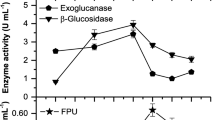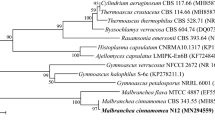Abstract
Wheat straw (Triticum aestivum) is one of the lignocellulosic materials largely available worldwide and could be potentially used for biofuel production. Aiming the cost-effective utilization of wheat straw in the sugar-based biorefineries, co-cultures of Trichoderma reesei and Monascus purpureus were used for the enzymatic hydrolysis of the wheat straw biomass. The enzymatic breakdown of the dual-fungi-treated wheat straw was chemically analyzed through different enzyme/compositional assays, and the structural modifications were studied through scanning electron microscope (SEM) and Fourier transform infrared spectroscopy (FTIR). For hydrolytic enzyme assays, the co-culture treatments resulted in significantly higher values (carboxymethyl cellulase (212.3 U/ml; p = 0.0173*), total cellulase (202 U/ml; p < 0.0001****), and xylanase (96.7 U/ml; p < 0.0001****) when compared with the readings of pure cultures. This hydrolytic activity resulted in the enhanced breakdown of wheat straw exhibiting a significant loss of 45.2% in lignin, 19.18% in cellulase, and 21.84% in hemicellulose contents. Furthermore, SEM and FTIR analysis of the co-culture treatments verified the improved biodegradation of wheat straw. Accumulatively, these results suggest a better approach for the effective use of dual-fungi for the lignocellulosic biomass breakdown and may have applications in bioethanol biorefineries using wheat straw as a sugar feedstock.

Graphical abstract





Similar content being viewed by others
References
Guo M, Song W, Buhain J (2015) Bioenergy and biofuels: history, status, and perspective. Renew Sust Energ Rev 42:712–725
Nicoletti G, Arcuri N, Nicoletti G, Bruno R (2015) A technical and environmental comparison between hydrogen and some fossil fuels. Energy Convers Manag 89:205–213
Machineni L (2019) Lignocellulosic biofuel production: review of alternatives. Biomass Convers Biorefinery:1–13
Sindhu R, Binod P, Pandey A (2016) Biological pretreatment of lignocellulosic biomass–an overview. Bioresour Technol 199:76–82
Wyman CE (2018) Ethanol production from lignocellulosic biomass: overview, handbook on bioethanol. Routledge:1–18
Fatma S, Hameed A, Noman M, Ahmed T, Shahid M, Tariq M, Sohail I, Tabassum R (2018) Lignocellulosic biomass: a sustainable bioenergy source for the future. Protein Pept Lett 25(2):148–163
Sun S, Sun S, Cao X, Sun R (2016) The role of pretreatment in improving the enzymatic hydrolysis of lignocellulosic materials. Bioresour Technol 199:49–58
Sharma HK, Xu C, Qin W (2019) Biological pretreatment of lignocellulosic biomass for biofuels and bioproducts: an overview. Waste Biomass Volari 10(2):235–251
Hatakka AI (1983) Pretreatment of wheat straw by white-rot fungi for enzymic saccharification of cellulose. Eur J Appl Microbiol Biotechnol 18(6):350–357
Dias AA, Freitas GS, Marques GS, Sampaio A, Fraga IS, Rodrigues MA, Evtuguin DV, Bezerra RM (2010) Enzymatic saccharification of biologically pre-treated wheat straw with white-rot fungi. Bioresour Technol 101(15):6045–6050
Buragohain P, Sharma N, Pathania S (2016) Use of wheat straw for extracellular cellulase production from Aspergillus niger F. J Biofuels 7(1):37–47
Karim RA, Hussain AS, Zain AM (2014) Production of bioethanol from empty fruit bunches cellulosic biomass and Avicel PH-101 cellulose. Biomass Convers Biorefinery 4(4):333–340
Kolasa M, Ahring BK, Lübeck PS, Lübeck M (2014) Co-cultivation of Trichoderma reesei RutC30 with three black Aspergillus strains facilitates efficient hydrolysis of pretreated wheat straw and shows promises for on-site enzyme production. Bioresour Technol 169:143–148
Paschos T, **ros C, Christakopoulos P (2015) Simultaneous saccharification and fermentation by co-cultures of Fusarium oxysporum and Saccharomyces cerevisiae enhances ethanol production from liquefied wheat straw at high solid content. Ind Crop Prod 76:793–802
Meehnian H, Jana AK, Jana MM (2017) Pretreatment of cotton stalks by synergistic interaction of Daedalea flavida and Phlebia radiata in co-culture for improvement in delignification and saccharification. Int Biodeterior Biodegrad 117:68–77
Bhattacharya AS, Bhattacharya A, Pletschke BI (2015) Synergism of fungal and bacterial cellulases and hemicellulases: a novel perspective for enhanced bio-ethanol production. Biotechnol Lett 37(6):1117–1129
Liao JC, Mi L, Pontrelli S, Luo S (2016) Fueling the future: microbial engineering for the production of sustainable biofuels. Nat Rev Microbiol 14(5):288–304
Park JJ, Yoo CG, Flanagan A, Pu Y, Debnath S, Ge Y, Ragauskas AJ, Wang ZY (2017) Defined tetra-allelic gene disruption of the 4-coumarate:coenzyme A ligase 1 (Pv4CL1) gene by CRISPR/Cas9 in switchgrass results in lignin reduction and improved sugar release. Biotechnol Biofuels 10(1):284–289
Kang SW, Park YS, Lee JS, Hong SI, Kim SW (2004) Production of cellulases and hemicellulases by Aspergillus niger KK2 from lignocellulosic biomass. Bioresour Technol 91(2):153–166
Romero M, Aguado J, González L, Ladero M (1999) Cellulase production by Neurospora crassa on wheat straw. Enzym Microb Technol 25(3):244–250
Singhania RR, Sukumaran RK, Patel AK, Larroche C, Pandey A (2010) Advancement and comparative profiles in the production technologies using solid-state and submerged fermentation for microbial cellulases. Enzym Microb Technol 46(7):541–549
Kumar R, Singh S, Singh OV (2008) Bioconversion of lignocellulosic biomass: biochemical and molecular perspectives. J Ind Microbiol Biotechnol 35(5):377–391
Bischof RH, Ramoni J, Seiboth B (2016) Cellulases and beyond: the first 70 years of the enzyme producer Trichoderma reesei. Microb Cell Factories 15(1):106–115
Duff SJ, Murray WD (1996) Bioconversion of forest products industry waste cellulosics to fuel ethanol: a review. Bioresour Technol 55(1):1–33
Daroit DJ, Silveira ST, Hertz PF, Brandelli A (2007) Production of extracellular β-glucosidase by Monascus purpureus on different growth substrates. Process Biochem 42(5):904–908
Mandels M, Sternberg D (1976) Recent advances in cellulase technology. J Ferment Technol 54(4):267–286
Sluiter A, Hames B, Ruiz R, Scarlata C, Sluiter J, Templeton D, Crocker D (2010) Determination of structural carbohydrates and lignin in biomass: laboratory analytical procedure, vol 1617, pp 1–16
Ghose T (1987) Measurement of cellulase activities. Pure Appl Chem 59(2):257–268
Adesina F, Onilude A (2013) Isolation, identification and screening of xylanase and glucanase-producing microfungi from degrading wood in Nigeria. Afr J Agric Res 8(34):4414–4421
Lowry OH, Rosebrough NJ, Farr AL, Randall RJ (1951) Protein measurement with the Folin phenol reagent. J Biol Chem 193(1):265–275
Miller GL (1959) Use of dinitrosalicylic acid reagent for determination of reducing sugar. Anal Chem 31(3):426–428
Zeng J, Singh D, Chen S (2011) Biological pretreatment of wheat straw by Phanerochaete chrysosporium supplemented with inorganic salts. Bioresour Technol 102(3):3206–3214
Chen Y, Huang J, Li Y, Zeng G, Zhang J, Huang A, Zhang J, Ma S, Tan X, Xu W, Zhou W (2015) Study of the rice straw biodegradation in mixed culture of Trichoderma viridae and Aspergillus niger by GC-MS and FTIR. Environ Sci Pollut Res Int 22(13):9807–9815
Kim SB, Lee SJ, Lee JH, Jung YR, Thapa LP, Kim JS, Um Y, Park C, Kim SW (2013) Pretreatment of rice straw with combined process using dilute sulfuric acid and aqueous ammonia. Biotechnol Biofuels 6(1):109–118
Nawaz S, Nelofer R, Tahir A, Syed Q (2018) Production of cellulase for ethanol fermentation from pretreated wheat straw. Iran J Sci Technol 42(2):321–329
Rehman O, Shahid A, Liu CG, Xu JR, Javed MR, Eid NH, Gull M, Nawaz M, Mehmood MA (2019) Optimization of low-temperature energy-efficient pretreatment for enhanced saccharification and fermentation of Conocarpus erectus leaves to produce ethanol using Saccharomyces cerevisiae. Biomass Convers Biorefinery:1–10
Shahryari Z, Fazaelipoor MH, Setoodeh P, Nair RB, Taherzadeh MJ, Ghasemi Y (2018) Utilization of wheat straw for fungal phytase production. Int J Recycl Organ Waste Agri 7(4):345–355
Ferreira JA, Mahboubi A, Lennartsson PR, Taherzadeh MJ (2016) Waste biorefineries using filamentous ascomycetes fungi: present status and future prospects. Bioresour Technol 215:334–345
Kogo T, Yoshida Y, Koganei K, Matsumoto H, Watanabe T, Ogihara J, Kasumi T (2017) Production of rice straw hydrolysis enzymes by the fungi Trichoderma reesei and Humicola insolens using rice straw as a carbon source. Bioresour Technol 233:67–73
Adsul M, Sharma B, Singhania RR, Saini JK, Sharma A, Mathur A, Gupta R, Tuli DK (2014) Blending of cellulolytic enzyme preparations from different fungal sources for improved cellulose hydrolysis by increasing synergism. RSC Adv 4(84):44726–44732
Khokhar Z, Syed Q, Nadeem M, Irfan M, Wu J, Samra Z, Gul I, Athar A (2014) Enhanced production of cellulase by Trichoderma reesei using wheat straw as a carbon source. World Appl Sci J 30(9):1095–1104
Pandey A, Höfer R, Taherzadeh M, Nampoothiri M, Larroche C (2015) Industrial biorefineries and white biotechnology. Elsevier, Berlin, pp 56–89
Arnthong J, Chuaseeharonnachai C, Boonyuen N, Tachaapaikun C, Chimchana D, Eurwilaichitr L, Champreda V, Chantasingh D (2018) Cooperative decomposition of rice straw by co-cultivation of cellulolytic fungi. Chiangmai J Sci 2:645–652
Anasontzis GE, Thuy NT, Hang DTM, Huong HT, Thanh DT, Hien DD, Thanh VN, Olsson L (2017) Rice straw hydrolysis using secretomes from novel fungal isolates from Vietnam. Biomass Bioenergy 99:11–20
Qadir F, Shariq M, Ahmed A, Sohail M (2018) Evaluation of a yeast co-culture for cellulase and xylanase production under solid state fermentation of sugarcane bagasse using multivariate approach. Ind Crop Prod 123:407–415
Tsegaye B, Balomajumder C, Roy P (2018) Biodegradation of wheat straw by Ochrobactrum oryzae BMP03 and Bacillus sp. BMP01 bacteria to enhance biofuel production by increasing total reducing sugars yield. Environ Sci Pollut Res Int 25(30):30585–30596
Magdouli S, Brar SK, Blais JF (2016) Co-culture for lipid production: advances and challenges. Biomass Bioenergy 92:20–30
Thakur S, Shrivastava B, Ingale S, Kuhad RC, Gupte A (2013) Degradation and selective ligninolysis of wheat straw and banana stem for an efficient bioethanol production using fungal and chemical pretreatment. 3. Biotech 3(5):365–372
Cone J, Baars J, Sonnenberg A, Hendriks W (2012) Fungal strain and incubation period affect chemical composition and nutrient availability of wheat straw for rumen fermentation. Bioresour Technol 111:336–342
Kannaiyan R, Mahinpey N, Kostenko V, Martinuzzi RJ (2017) Enhanced delignification of wheat straw by the combined effect of hydrothermal and fungal treatments. Chem Eng Commun 204(7):803–812
Pedraza-Zapata DC, Sanchez-Garibello AM, Quevedo-Hidalgo B, Moreno-Sarmiento N, Gutierrez-Rojas I (2017) Promising cellulolytic fungi isolates for rice straw degradation. J Microbiol 55(9):711–719
Shah T, Ullah R (2019) Pretreatment of wheat straw with ligninolytic fungi for increased biogas productivity. Int J Environ Sci Technol:1–12
Kaushik A, Singh M, Verma G (2010) Green nanocomposites based on thermoplastic starch and steam exploded cellulose nanofibrils from wheat straw. Carbohydr Polym 82(2):337–345
Oh SY, Yoo DI, Shin Y, Seo G (2005) FTIR analysis of cellulose treated with sodium hydroxide and carbon dioxide. Carbohydr Res 340(3):417–428
Kirk TK, Farrell RL (1987) Enzymatic" combustion": the microbial degradation of lignin. Annu Rev Microbiol 41(1):465–501
Tandy S, Healey JR, Nason MA, Williamson JC, Jones DL, Thain SC (2010) FT-IR as an alternative method for measuring chemical properties during composting. Bioresour Technol 101(14):5431–5436
Xu F, Zhou QA, Sun JX, Liu CF, Ren JL, Sun RC, Curling S, Fowler P, Baird MS (2007) Fractionation and characterization of chlorophyll and lignin from de-juiced Italian ryegrass (Lolium multifolrum) and timothy grass (Phleum pratense). Process Biochem 42(5):913–918
Pandey KK, Pitman A (2003) FTIR studies of the changes in wood chemistry following decay by brown-rot and white-rot fungi. Int Biodeterior Biodegrad 52(3):151–160
Navarini L, Gilli R, Gombac V, Abatangelo A, Bosco M, Toffanin R (1999) Polysaccharides from hot water extracts of roasted Coffea arabica beans: isolation and characterization. Carbohydr Polym 40(1):71–81
Laureano-Perez L, Teymouri F, Alizadeh H, Dale BE (2005) Understanding factors that limit enzymatic hydrolysis of biomass. Appl Biochem Biotechnol 124(3):1081–1099
Funding
This study was supported by the Higher Education Commission (HEC), Government of Pakistan, and PAK−US project: 4−Romana/AK−US/HEC/2011 “Solid waste management for Bioenergy production.”
Author information
Authors and Affiliations
Corresponding authors
Ethics declarations
Conflict of interest
The authors declare that they have no conflict of interest.
Additional information
Publisher’s Note
Springer Nature remains neutral with regard to jurisdictional claims in published maps and institutional affiliations.
Highlights
• Biodegradation of wheat straw was evaluated using mono- and co-culture of T. reesei and M. purpureus under solid-state fermentation.
• Hydrolytic enzyme activity of mono- and co-culture treatments was analyzed and compared.
• Compositional analysis and structural modifications of biodegraded wheat straw were observed to compare the structural loss/gain of lignocellulosic constituents.
• A significant enhancement of biodegradation of wheat straw with fungal co-cultures suggested the synergism among the fungi for the cooperative work.
Rights and permissions
About this article
Cite this article
Fatma, S., Saleem, A. & Tabassum, R. Wheat straw hydrolysis by using co-cultures of Trichoderma reesei and Monascus purpureus toward enhanced biodegradation of the lignocellulosic biomass in bioethanol biorefinery. Biomass Conv. Bioref. 11, 743–754 (2021). https://doi.org/10.1007/s13399-020-00652-x
Received:
Revised:
Accepted:
Published:
Issue Date:
DOI: https://doi.org/10.1007/s13399-020-00652-x




